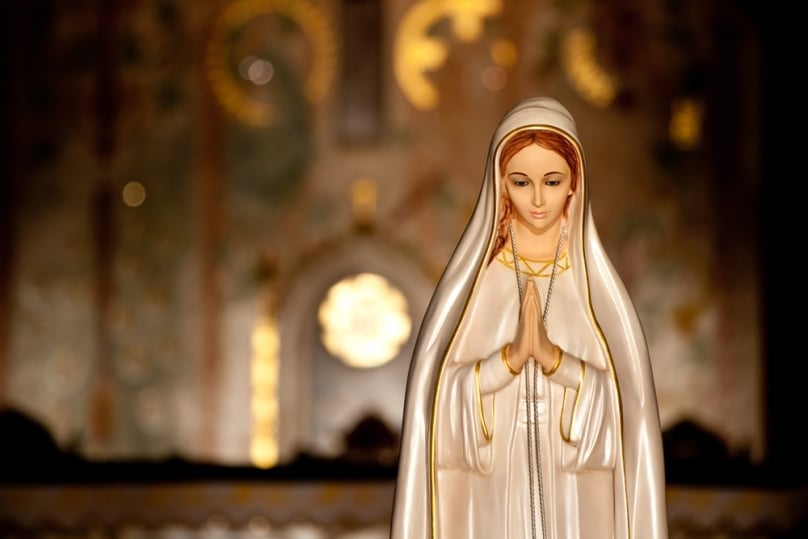
Dear Father, With regard to the feast of the Queenship of Mary, I have two questions: Is this an ancient or a modern feast, and in what way can we consider Our Lady to be a queen?
The feast is modern, having been instituted by Pope Pius XII in 1954 in the encyclical Ad Caeli Reginam (To the Queen of Heaven).
In that document the pope indicated the reason for instituting the feast: “Following the frightful calamities which before our very eyes have reduced flourishing cities, towns, and villages to ruins, we see to our sorrow that many great moral evils are being spread abroad in what may be described as a violent flood. Occasionally we behold justice giving way; and, on the one hand and the other, the victory of the powers of corruption. The threat of this fearful crisis fills us with a great anguish, and so with confidence we have recourse to Mary our Queen, making known to her those sentiments of filial reverence which are not ours alone, but which belong to all those who glory in the name of Christian” (n. 2).
In what way can we consider Our Lady a queen?
Pope Pius went on in his encyclical to answer the question: “From early times Christians have believed, and not without reason, that she of whom was born the Son of the Most High received privileges of grace above all other beings created by God. He ‘will reign in the house of Jacob forever’ (Lk 1:32), ‘the Prince of Peace’ (Is 9:6), the ‘King of Kings and Lord of Lords’ (Rev 19:16).
And when Christians reflected upon the intimate connection that obtains between a mother and a son, they readily acknowledged the supreme royal dignity of the Mother of God” (n. 8).
For this reason, early writers of the Church called Our Lady “Mother of the King” and “Mother of the Lord”, signifying that she derived a certain eminence from the royal dignity of her Son (cf. n. 9).
Pope Pius went on to cite various Fathers of the Church who speak of Mary’s role as Queen, among them St Ephrem, who represents Mary as saying: “Let Heaven sustain me in its embrace, because I am honoured above it. For heaven was not thy mother, but thou hast made it thy throne. How much more and venerable than the throne of a king is her mother” (Hymni de B. Maria).
In another place the same saint prays to Mary: “Majestic and Heavenly Maid, Lady, Queen, protect and keep me under your wing lest Satan the sower of destruction glory over me, lest my wicked foe be victorious against me” (Oratio ad Ss.mam Dei Matrem).
Similarly, St Germanus speaks to Our Lady in these words: “Be enthroned, Lady, for it is fitting that you should sit in an exalted place since you are a Queen and glorious above all kings” (In Praesentationem Ss.mae Deiparae). He likewise calls her the “Queen of all of those who dwell on earth” (idem).
The popes too have called Mary Queen from the early centuries.
For example, in the eighth century Pope Gregory II wrote a letter to St Germanus, which was read out and accepted in the Second Council of Nicaea in 787, in which he called Our Lady “the Queen of all, the true Mother of God,” and also “the Queen of all Christians” (Hardouin, Acta Conciliorum, IV, 234).
Among the saints who have referred to Mary as Queen is St Alphonsus Liguori, who wrote: “Because the Virgin Mary was raised to such a lofty dignity as to be the mother of the King of Kings, it is deservedly and by every right that the Church has honoured her with the title of ‘Queen’” (Le glone de Maria, p. I, c. I, §1).
Mary is honoured as Queen too in such ancient prayers and hymns as the Salve Regina, (Hail, Holy Queen), which dates to the eleventh century (cf. J. Flader Question Time 3, q. 420, Connor Court 2016) and the Regina Coeli (“Queen of Heaven, rejoice”) from the twelfth century (cf. J. Flader QuestionTime 1, q. 130, Connor Court 2012).
So there is every reason to call Mary our Queen. We should honour her and put into practice what Pope Pius recommended at the end of his encyclical: “Let all, therefore, try to approach with greater trust the throne of grace and mercy of our Queen and Mother, and beg for strength in adversity, light in darkness, consolation in sorrow; above all let them strive to free themselves from the slavery of sin and offer an unceasing homage, filled with filial loyalty, to their Queenly Mother” (n. 48).
